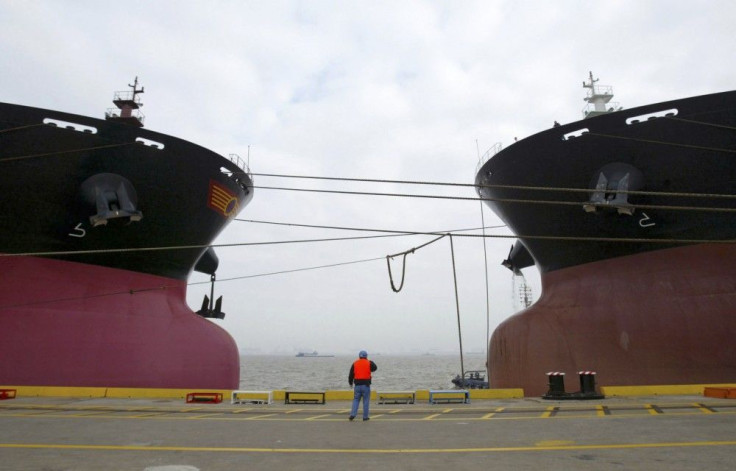Biggest Freighters Hit Hardest In Global Shipping Storm

The cargo ship Yuritamou is a marvel of modern engineering. Built to withstand pirate attacks and sail through typhoons, it looks from the shore like an immense wall of black and red, soaring 148 feet high and stretching nearly four football fields long.
So large is the Yuritamou that in just one trip from the rich mining regions of western Australia to the hungry foundries of northeastern China, the ship can carry over 181,000 tons of iron ore -- enough metal to build 30,000 cars, two skyscrapers or one world-class suspension bridge.
Yet the Yuritamou isn't making that trip this month. Instead, it is circling its anchor off China's port of Tianjin as several dozen mariners aboard spend their days smoking cigarettes and staring at the filthy bay below.
No Optimism
To understand why the Yuritamou isn't sailing is to understand the precarious state of worldwide shipping, which, buffeted by a flood of oversupply, waning demand and a sea of red ink since late last year, is slowly and painfully recovering.
From October 2011, as shipping companies absorbed a glut of newly built ships commissioned during the pre-recession boom years, prices for shipping dry cargo have collapsed worldwide. The Baltic Dry Index, the benchmark measure of international shipping costs for grains, metals and other dry cargo, fell over 70 percent from mid-October until Feb. 3, when it hit an historical nadir. The index is up 38.5 percent since then, but that has not taken global shippers out of their financial doldrums.
The main issue of the moment: while shipping costs have been steadily recovering, rates for the largest vessels -- called Capesize because they're too large to navigate the Suez Canal and must circumnavigate the Cape of Good Hope to make it around Africa -- have kept sinking.
Any optimism in the market earlier on has disappeared, Andreas Loftesnes, a Singapore-based broker at Freight Investor Services Ltd., recently told Reuters.
A Financial Whirlpool
It is somewhat of a chicken-and-egg situation.
With banks aware of the difficult business environment being faced by shippers and shipbrokers, some financial institutions are turning off the short-term financing spigot or refusing to refinance loans the shipping companies need to stay afloat. Ship brokers, now cut off from the precious financial liquidity to which they had been accustomed, are defaulting on loans or asking for extensions. All of this is stoking fears that banks will balk and choose to arrest the fleets of delinquent brokers and keep their vessels moored as collateral.
Deutsche Bank might have become the first major player to take that drastic action, when it had the British Admiralty detain four ships managed by VW-Nyki Shipping, a Dutch concern, that were sitting in English ports.
Clients, aware of the financial pitfalls facing the shippers, are reluctant to do business with ones that might lose their ships to the banks. And where they are doing business, they are choosing to lease smaller ships, figuring it better to risk having 50,000 to 60,000 tons of cargo held up in a foreign port than the more than 150,000 tons that Capesize ships can haul.
Which means large-ship lessors get dragged even deeper into the financial whirlpool.
Less Than Operational Costs
Such dynamics seem to have befallen the Yuritamou. Earlier in the month, a Dutch trading company set a contract to lease the giant bulker for four to eight months from its owner, the Japanese Sanko line. But the deal was dropped just days later, after Sanko said it was suspending debt payments to creditors.
It is by far not the only idle large ship. Average daily earnings for Capesize ships, on slack demand, are currently down to $4,881, a drop of over 84 percent this year alone, and less than half the rate being fetched by Supramax-sized ships, which carry less than half the load. Analysts say ships must average at least $8,000 in earnings per day to cover operational costs.
And its only been the latest in a long decline: In 2008, right before the global recession began to bite international trade, Capesize owners were charging over $200,000 a day.
Other Storms Brewing
Financial market dynamics, however, aren't the only thing depressing large ship leasing.
Incidents like the recent collapse of a key bridge in Brazil on March 16, which cut off rail access to that country's largest ore mine, and a recent Category 4 cyclone off the Australian coast, have disrupted the global iron supply chain. That pressures all shipping, but especially Capesize vessels, for whom iron ore transportation amounts to more than one-third of the total business.
But those weather-related occurrences, while painful to the industry, are only temporary. Much more disruptive is the expected global slowdown in steel consumption, as the Chinese economy stops supporting massive building ventures.
Already, there is evidence suppliers are cutting operations in the face of the oncoming industrial contraction. Tuesday, AcelorMittal, the world's biggest steel producer, announced it was indefinitely idling a major unit in its home country, in what analysts believe will be the first of many such announcements.
While we think China will still be the main driver for the dry bulk market, a deceleration in growth of steel production has been largely expected as governmental bodies are pressing hard for phasing out obsolete capacity and consolidation of smaller mills, Erik Nikolai Stavseth, an analyst at Arctic Securities, told Reuters.
And that could really make the anchor drop.
© Copyright IBTimes 2024. All rights reserved.


















